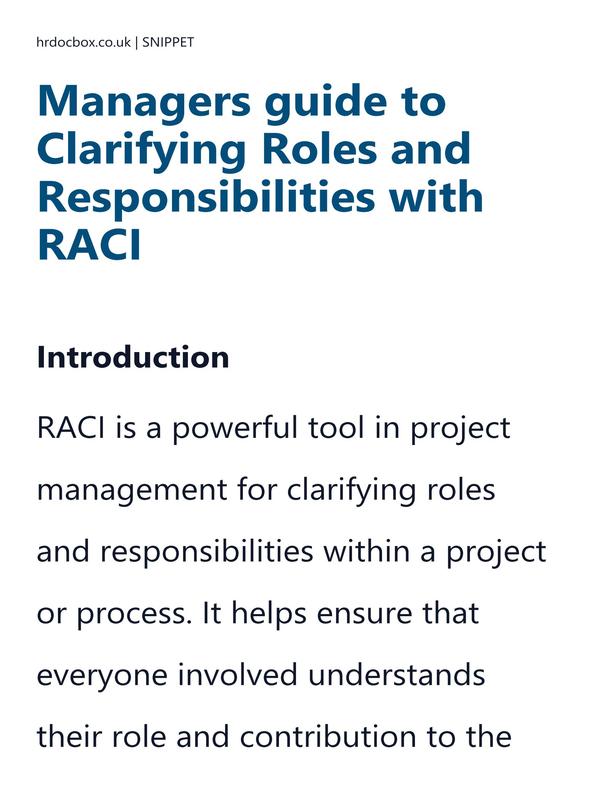Managers guide to Clarifying Roles and Responsibilities with RACI


Our Guide to Clarifying Roles and Responsibilities with RACI aids in defining clear accountabilities, ensuring efficient task delegation and project management within teams.
- Includes Managers guide to Clarifying Roles and Responsibilities with RACI + 12 months’ access, with all updates to this page provided free of charge and notified to you.
- UK-specific accuracy.
- 567 words over 2 pages.
- Last updated 31/03/2024.
- Format: Word / PDF / plain text / email.
- Delivery: Instant download after purchase (no physical item).
- Access: Download link shown here after checkout.
- This Managers guide to Clarifying Roles and Responsibilities with RACI will SAVE you up to 1 hour 30 mins research. Save cost. Reduce risk.
Managers guide to Clarifying Roles and Responsibilities with RACI
Introduction
RACI is a powerful tool in project management for clarifying roles and responsibilities within a project or process. It helps ensure that everyone involved understands their role and contribution to the project's success. This guide aims to explain the RACI framework and provide practical tips for implementing it effectively.
What is RACI?
RACI stands for Responsible, Accountable, Consulted, and Informed. Each letter corresponds to a role in a project or process:
-
Responsible (R): The person or people who are responsible for completing the work or task. They are accountable for the execution and delivery of the task.
-
Accountable (A): The person who is ultimately answerable for the task's success or failure. This is usually the person who delegates the work to the responsible party.
-
Consulted (C): Those whose opinions, expertise, or input are sought before a decision or action is taken. They provide valuable insights and guidance but are not directly responsible for the task's execution.
-
Informed (I): Those who
This is a 30% preview of the Managers guide to Clarifying Roles and Responsibilities with RACI. For instant full access, purchase this item or a parent bundle.
Managers guide to Clarifying Roles and Responsibilities with RACI
The Guide to Clarifying Roles and Responsibilities with RACI provides a structured approach for defining and communicating accountabilities within a project or organisation.
Using the RACI (Responsible, Accountable, Consulted, Informed) matrix, it helps teams identify who is responsible for each task, who has final decision-making authority, and who needs to be consulted or informed throughout the process.
This guide enhances organisational efficiency by eliminating role ambiguity and ensuring clarity regarding individual responsibilities. By employing the RACI framework, teams can streamline workflows, improve accountability, and enhance collaboration, ultimately driving successful project outcomes and organisational effectiveness.
Frequently Asked Questions about a Managers guide to Clarifying Roles and Responsibilities with RACI
Frequently Asked Questions about a Managers guide to Clarifying Roles and Responsibilities with RACI
-
Can I use this template in my small business?
Yes. The Managers guide to Clarifying Roles and Responsibilities with RACI is designed to be flexible and suitable for organisations of all sizes, including small businesses and charities. It follows UK employment law best practice, so even if you don't have an in-house HR team, you can confidently apply it.
-
Is the Managers guide to Clarifying Roles and Responsibilities with RACI compliant with 2026 UK employment law?
Absolutely. All of our templates are drafted with the latest ACAS guidance and UK employment legislation in mind. We review and update them regularly, so you can be confident they remain compliant.
-
Can I customise it for my organisation?
Yes, we highlight the areas that you need to update with your own details, and where you need to make decisions to suit your situation. This saves you time and ensures that you meet best practice.
-
Do I get instant access?
Yes. Once purchased, you'll be able to download it instantly. Templates are provided in editable Word or Excel format so you can customise them easily, and in PDF format for easy sharing.
-
What if I need more help, not just this template?
If you're looking for broader support, we also offer toolkits and library bundles that include this template, along with other HR templates and policies for fully managing your situation. These may be more cost-effective if you need deeper advice.
-
Why should I use this, and not AI to generate this template?
The risk of using a free AI-generated template 'without review' includes your legal exposure, missing context, and no awareness of the wider process. Purchasing from us mitigates that risk.
